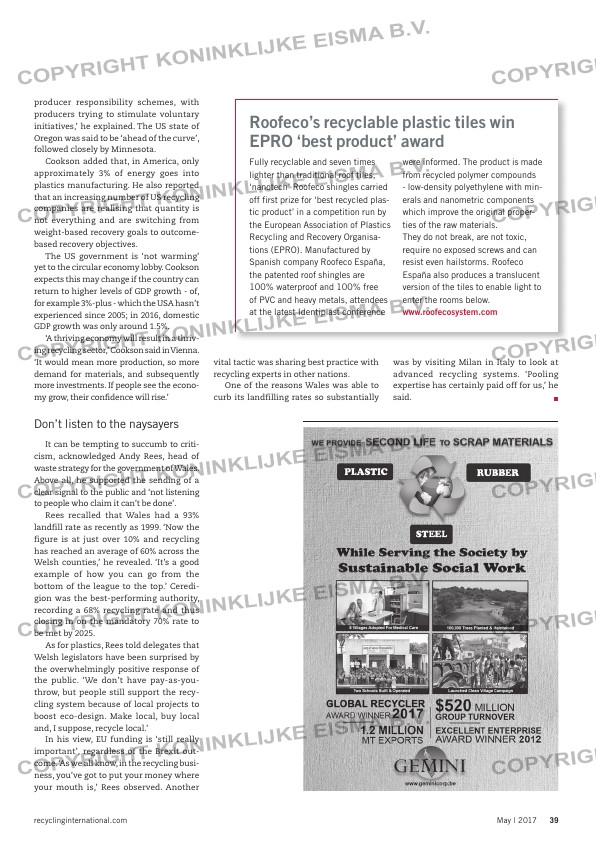Page 41 from: Edition 3 2017

39May | 2017recyclinginternational.com
producer responsibility schemes, with
producers trying to stimulate voluntary
initiatives,’ he explained. The US state of
Oregon was said to be ‘ahead of the curve’,
followed closely by Minnesota.
Cookson added that, in America, only
approximately 3% of energy goes into
plastics manufacturing. He also reported
that an increasing number of US recycling
companies are realising that quantity is
not everything and are switching from
weight-based recovery goals to outcome-
based recovery objectives.
The US government is ‘not warming’
yet to the circular economy lobby. Cookson
expects this may change if the country can
return to higher levels of GDP growth – of,
for example 3%-plus – which the USA hasn’t
experienced since 2005; in 2016, domestic
GDP growth was only around 1.5%.
‘A thriving economy will result in a thriv-
ing recycling sector,’ Cookson said in Vienna.
‘It would mean more production, so more
demand for materials, and subsequently
more investments. If people see the econo-
my grow, their confidence will rise.’
Don’t listen to the naysayers
It can be tempting to succumb to criti-
cism, acknowledged Andy Rees, head of
waste strategy for the government of Wales.
Above all, he supported the sending of a
clear signal to the public and ‘not listening
to people who claim it can’t be done’.
Rees recalled that Wales had a 93%
landfill rate as recently as 1999. ‘Now the
figure is at just over 10% and recycling
has reached an average of 60% across the
Welsh counties,’ he revealed. ‘It’s a good
example of how you can go from the
bottom of the league to the top.’ Ceredi-
gion was the best-performing authority,
recording a 68% recycling rate and thus
closing in on the mandatory 70% rate to
be met by 2025.
As for plastics, Rees told delegates that
Welsh legislators have been surprised by
the overwhelmingly positive response of
the public. ‘We don’t have pay-as-you-
throw, but people still support the recy-
cling system because of local projects to
boost eco-design. Make local, buy local
and, I suppose, recycle local.’
In his view, EU funding is ‘still really
important’, regardless of the Brexit out-
come. ‘As we all know, in the recycling busi-
ness, you’ve got to put your money where
your mouth is,’ Rees observed. Another
vital tactic was sharing best practice with
recycling experts in other nations.
One of the reasons Wales was able to
curb its landfilling rates so substantially
was by visiting Milan in Italy to look at
advanced recycling systems. ‘Pooling
expertise has certainly paid off for us,’ he
said.
Roofeco’s recyclable plastic tiles win
EPRO ‘best product’ award
Fully recyclable and seven times
lighter than traditional roof tiles,
‘nanotech’ Roofeco shingles carried
off first prize for ‘best recycled plas-
tic product’ in a competition run by
the European Association of Plastics
Recycling and Recovery Organisa-
tions (EPRO). Manufactured by
Spanish company Roofeco España,
the patented roof shingles are
100% waterproof and 100% free
of PVC and heavy metals, attendees
at the latest Identiplast conference
were informed. The product is made
from recycled polymer compounds
– low-density polyethylene with min-
erals and nanometric components
which improve the original proper-
ties of the raw materials.
They do not break, are not toxic,
require no exposed screws and can
resist even hailstorms. Roofeco
España also produces a translucent
version of the tiles to enable light to
enter the rooms below.
www.roofecosystem.com



